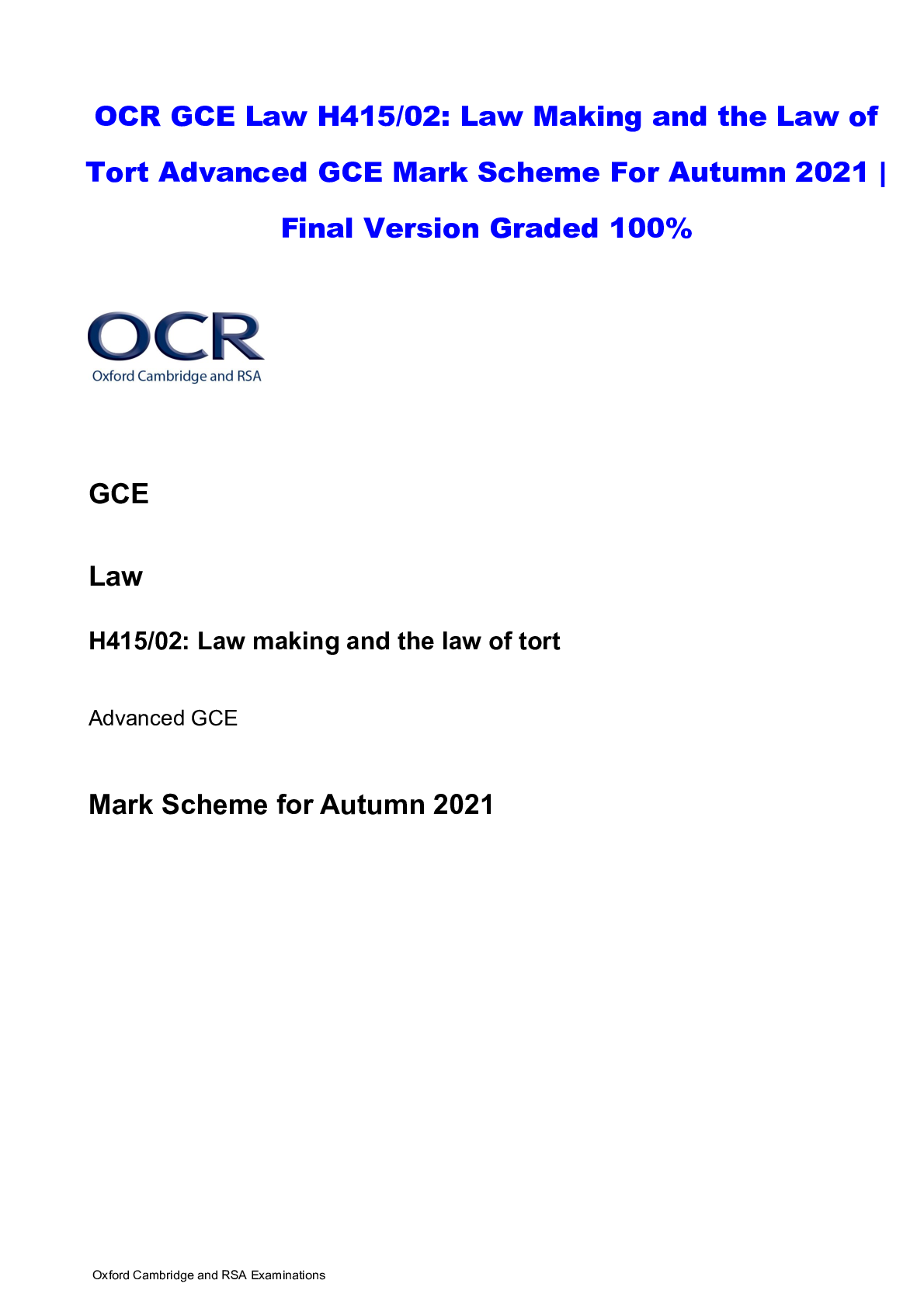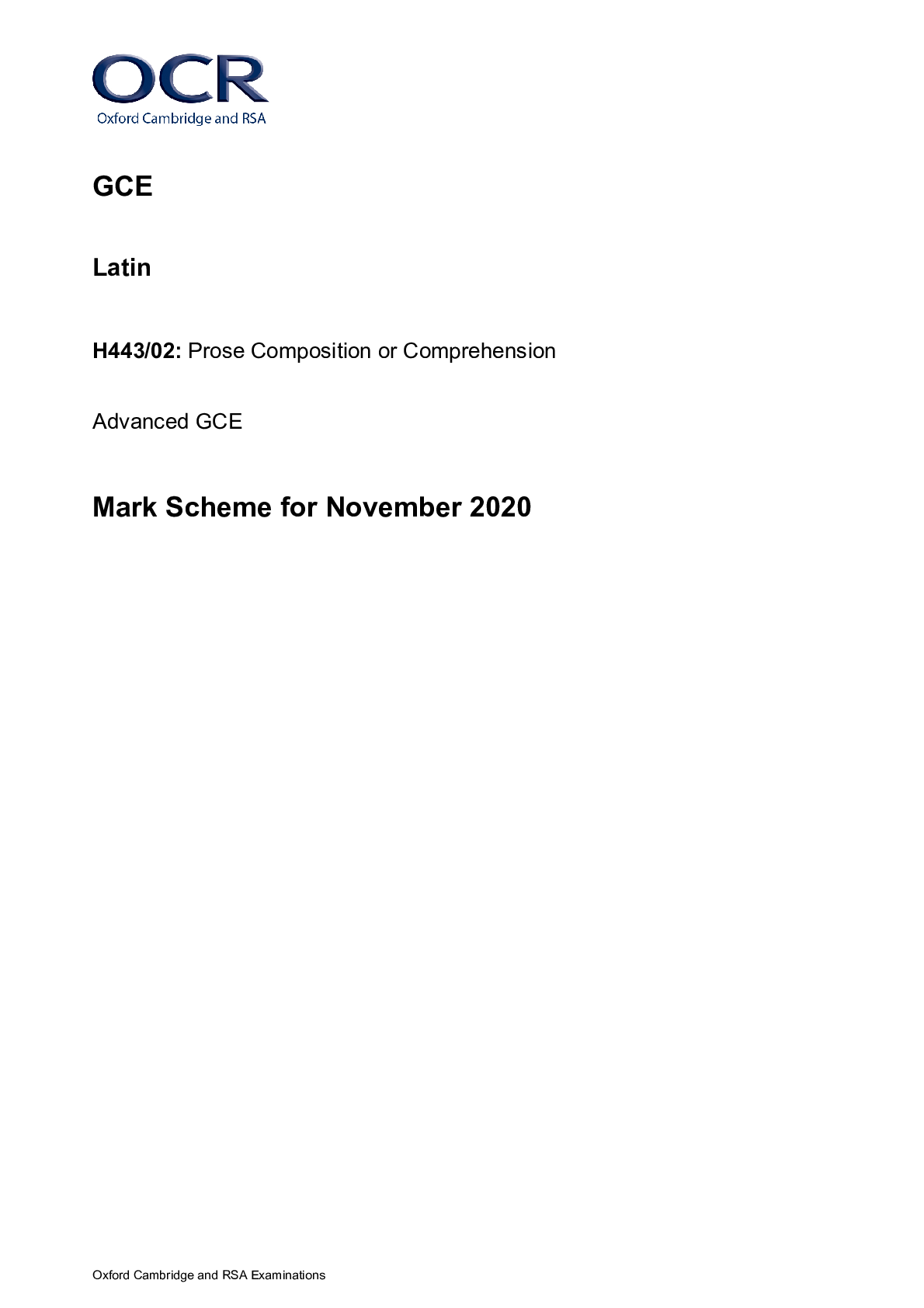Biology > GCSE MARK SCHEME > GCE Biology A H420/01: Biological processes Advanced GCE Mark Scheme for November 2020 (All)
GCE Biology A H420/01: Biological processes Advanced GCE Mark Scheme for November 2020
Document Content and Description Below
GCE Biology A H420/01: Biological processes Advanced GCE Mark Scheme for November 2020 Oxford Cambridge and RSA Examinations GCE Biology A H420/01: Biological processes Advanced GCE Mark Scheme ... for November 2020Oxford Cambridge and RSA Examinations OCR (Oxford Cambridge and RSA) is a leading UK awarding body, providing a wide range of qualifications to meet the needs of candidates of all ages and abilities. OCR qualifications include AS/A Levels, Diplomas, GCSEs, Cambridge Nationals, Cambridge Technicals, Functional Skills, Key Skills, Entry Level qualifications, NVQs and vocational qualifications in areas such as IT, business, languages, teaching/training, administration and secretarial skills. It is also responsible for developing new specifications to meet national requirements and the needs of students and teachers. OCR is a not-for-profit organisation; any surplus made is invested back into the establishment to help towards the development of qualifications and support, which keep pace with the changing needs of today’s society. This mark scheme is published as an aid to teachers and students, to indicate the requirements of the examination. It shows the basis on which marks were awarded by examiners. It does not indicate the details of the discussions which took place at an examiners’ meeting before marking commenced. All examiners are instructed that alternative correct answers and unexpected approaches in candidates’ scripts must be given marks that fairly reflect the relevant knowledge and skills demonstrated. Mark schemes should be read in conjunction with the published question papers and the report on the examination. © OCR 2020Annotations Annotation Meaning DO NOT ALLOW Answers which are not worthy of credit IGNORE Statements which are irrelevant ALLOW Answers that can be accepted ( ) Words which are not essential to gain credit __ Underlined words must be present in answer to score a mark ECF Error carried forward AW Alternative wording ORA Or reverse argumentH420/01 Mark Scheme November 2020 4 Subject-specific Marking Instructions INTRODUCTION Your first task as an Examiner is to become thoroughly familiar with the material on which the examination depends. This material includes: • the specification, especially the assessment objectives • the question paper • the mark scheme. You should ensure that you have copies of these materials. You should ensure also that you are familiar with the administrative procedures related to the marking process. These are set out in the OCR booklet Instructions for Examiners. If you are examining for the first time, please read carefully Appendix 5 Introduction to Script Marking: Notes for New Examiners. Please ask for help or guidance whenever you need it. Your first point of contact is your Team Leader.H420/01 Mark Scheme November 2020 9 Question Answer Marks AO element Guidance 1 D 1 1.2 2 B 1 1.1 3 A 1 1.1 4 A 1 1.1 5 B 1 1.1 6 B 1 1.1 7 B 1 1.1 8 B 1 1.1 9 A 1 2.6 10 A 1 2.6 11 C 1 2.3 12 C 1 2.4 13 B 1 1.1 14 C 1 1.2 15 B 1 2.5 Total 15H420/01 Mark Scheme November 2020 6 Question Answer Marks AO element Guidance 16 (a) (i) adenine 1 2.1 DO NOT ALLOW adenosine IGNORE nitrogenous base / purine (a) (ii) hydrolysis 1 2.1 IGNORE dephosphorylation (a) (iii) because ATP is , broken down / hydrolysed (to ADP) ATP is constantly recycled ATP used to provide energy for , (named) metabolic reactions / processes ATP is , not stored long term / used immediately max 2 2.1 ALLOW ATP is unstable ALLOW constant interconversion of ATP and ADP (+Pi) ALLOW ATP produced is coupled to metabolic reactions IGNORE used for respiration unqualified ALLOW ATP is used as fast as it is producedH420/01 Mark Scheme November 2020 7 Question Answer Marks AO element Guidance 16 (b) (i) Substance A 1 for (substance) A the , graph is a straight line / rate of uptake depends on concentration 2 (so substance) A is (absorbed by simple) diffusion Substance B 3 for (substance) B the curve , reaches a plateau / levels off 4 (so substance) B could be (absorbed by) , facilitated diffusion / active transport 5 (because) if facilitated diffusion channels / carrier proteins , become saturated OR (because) if active transport carrier proteins / carriers , become saturated 4 max 3.1 3.2 ALLOW rate is (directly) proportional to concentration ALLOW as concentration increases rate increases DO NOT ALLOW facilitated diffusion ALLOW rate becomes constant DO NOT ALLOW rate slows IGNORE stops increasing ALLOW channels / carriers working at maximum capacity ALLOW transport proteins for either in MP5 DO NOT ALLOW channel proteins for active transportH420/01 Mark Scheme November 2020 8 16 (b) (ii) Substance A effect (uptake) unaffected / no change explanation (simple) diffusion , does not require ATP / is a passive process Substance B effect if active transport slower / little / reduced / no (uptake) explanation active transport , requires ATP / is an active process OR effect if facilitated diffusion (uptake) unaffected / no change explanation facilitated diffusion , does not require ATP / is a passive process max 4 3.1 2.5 CHECK answer to (b)(i) ALLOW ECF if answer to part (i) suggests candidate thinks substance A is taken up by active transport and Substance B is taken up entirely by diffusion. ALLOW does not require energy ALLOW does not require energyH420/01 Mark Scheme November 2020 9 Question Answer Marks AO element Guidance 16 (c) Improvement Justification To assess repeatability Use a colorimeter with a digital display showing absorbance units to 3 decimal places. To assess reproducibility Check the zero value of the colorimeter with purified water before use. To reduce systematic error For each concentration, repeat the measurement of the rate of reaction three times and calculate a mean. To reduce random error (uncertainty) Ask students in several schools to carry out the same investigation. To increase resolution 4 2.3 One mark per correct line DO NOT ALLOW more than one line per boxH420/01 Mark Scheme November 2020 10 Question Answer Marks AO element Guidance 17 (a) (i) Rf = 0.53 / 0.52 pigment = chlorophyll a 3 2.4 3.2 If incorrect: ALLOW for 1 mark for correct use of � � = (�������� ����� �� ����) (�������� ����� �� �������) e.g. �� = (46) (86) OR inappropriate use of sig. figs e.g. 0.533 / 0.5 ALLOW ECF if incorrect calculation IGNORE colour e.g. blue-green (a) (ii) grey 1 2.4 ALLOW ECF from calculated Rf value in part (ii) (for ECF looking for a pigment next highest in value than calculated as spot 4 has travelled further from origin than spot 3) ECF list: 0.32-0.44 - prediction = green 0.49 - prediction= blue-green 0.65 -prediction = yellow-orange (a) (iii) spot 5 (because) is most soluble in , mobile phase / solvent 2 2.3 2.4 ALLOW is less attracted to stationary phase / TLC plateH420/01 Mark Scheme November 2020 11 17 (b) (i) hold TLC plate carefully (so that) movement of spots not affected (by damage) OR (so that) plates are not contaminated (by fingerprints / oils from skin) make sure plate doesn’t touch sides of jar (because) condensation / liquid / solvent , on walls of jar may affect movement of spots OR to avoid , solvent / spots , travelling in wrong direction 2 1.2 MUST be linked to appropriate precaution ALLOW e.g. pigments for ‘spots’ (b) (ii) to , reduce / avoid / prevent , damage / degradation / contamination / AW , of the (photosynthetic) pigments to , reduce / avoid , evaporation of propanone / solvent 1 max 1.2 (c) GP 1 (concentration of) GP decreases 2 (GP decreases) because less CO2 available to react with RuBP to produce GP RuBP (2 max) 3 (concentration of) RuBP increases AND then decreases 4 RuBP increases because it is not converted to GP 5 RuBP increases as it is still being produced from TP 3 max 2.3 IGNORE 6C intermediates ALLOW no / less , carbon (dioxide) fixation taking place Max 2 from MPs 3,4, 5 and 6H420/01 Mark Scheme November 2020 12 6 RuBP decreases because less GP available to , regenerate / AW , RuBP H420/01 Mark Scheme November 2020 13 Question Answer Marks AO element Guidance 18 (a) because it is , charged / polar / hydrophilic (so) cannot pass through the phospholipid bilayer / will need correct transport proteins OR because it is (too) large (so) cannot pass through the phospholipid bilayer / will need correct transport proteins 2 max 2.1 ALLOW repelled by phospholipid bilayer ALLOW hydrophobic centre / fatty acid tails for phospholipid bilayer IGNORE cell membrane IGNORE cell membrane (b) (i) can be used with , living cells / thick samples AVP 1 max 2.3 Mark first response e.g. high resolution e.g. can see distribution of molecules within cells e.g. can control depth of field e.g. sharper / less blurred imageH420/01 Mark Scheme November 2020 14 18 (b) (ii) conclusion is valid because: 1 concentration of Ca2+ is proportional to strength of stimulus 2 Ca2+ change from low to , medium / high , causes increase in (membrane) potential 3 action potential in , presynaptic neurone / synaptic bulb , leads to , opening of Ca2+ channels / entry of Ca2+ 4 Ca2+ , causes / AW , release of (named) neurotransmitter 5 (named) neurotransmitter causes , Na+ / sodium ion , channels to open in (post-synaptic) neurone 6 if threshold is exceeded this causes , action potential in (postsynaptic) neurone / depolarises (postsynaptic) membrane conclusion may not be valid because: 7 changes in Ca2+ concentration may not be the cause of (postsynaptic) action potential 8 Ca2+ change from medium to high but no change in (membrane) potential 4 max 2.4 3.2 ALLOW calcium ions for Ca2+ throughout DO NOT ALLOW Ca+ / calcium but penalise once then ECF ALLOW reference to +40 mV as alternative to action potential throughout IGNORE ref to fluorescence / FURA-2 MP 1 ALLOW e.g. the greater the strength of stimulus the greater the Ca2+ concentration MP2 ALLOW figs go from -60 to +40mV MP8 ALLOW figs stay at + 40mVH420/01 Mark Scheme November 2020 16 Question Answer Marks AO element Guidance 19 (a) (i) transmission electron (microscope) 1 2.1 ALLOW TEM, ‘microscopy’ for ‘microscope’ (a) (ii) M = matrix N = crista(e) 2 1.1 ALLOW inner membrane for N (b) contain / location of , (named) electron carriers / ETC / ATP synth(et)ase / proton pumps (provide , site / location / surface ) for , chemiosmosis / ATP synthesis / oxidative phosphorylation allow , formation / maintenance , of , H+ / proton / hydrogen ion , gradient outer membrane is highly permeable to allow movement of (named) molecules max 2 1.1 Mark as continuous prose (c) (i) length / size , similar to that of a bacterium contain (circular) DNA contain (70S / small / 20nm) ribosomes (may) have plasmids have double membrane max 2 3.2 2.1 If more than two responses given: mark first response on each prompt line. If responses on first prompt line and nothing on second line then mark first two on first prompt line (c) (ii) cells with mitochondria / early eukaryotes 1 would be able to respire aerobically 2 (this) produces more ATP 3 ATP needed for , active transport / cell division / protein synthesis / DNA replication 3 2.1 Assume for cells with mitochondria Only need to mention ATP once ALLOW ORA for cells without mitochondria for MPs 1, 2, 4 ALLOW releases more energy DO NOT ALLOW ‘produces’ energy IGNORE growthH420/01 Mark Scheme November 2020 17 Question Answer Marks AO element Guidance 4 more ATP allows faster metabolic , processes / reactions ALLOW more ATP so can meet higher metabolic demand 20 (a) (i) rinse / change , flask / equipment stir yeast , (stock) solution / suspension (yeast stock solution made from) same type of yeast ensure connection to gas syringe is tight check temperature of , water bath / yeast (stock) solution , is 35 ºC max 2 3.3 ALLOW e.g. use different stirrer each time ALLOW ensure no leaks in gas syringe (ii) boiled (and cooled) yeast / use buffer instead of yeast 1 3.3 (b) (i) 1 rate of respiration is proportional to rate of gas production 2 use a tangent (on non linear part of curve) 3 measure / calculate , slope / gradient (of each line) 4 volume of gas (collected) divided by time 5 compare the same , time / period (between sugars) max 3 2.3 3.3 ALLOW MPs 2, 3 and 5 from annotation of graph ALLOW seen as units e.g. cm3 min-1 ALLOW within prose / calculationsH420/01 Mark Scheme November 2020 18 Question Answer Marks AO element Guidance Summary of instructions to markers: See instruction 10 on page 5 of this mark scheme. 20 (b) (ii)* Level 3 (5–6 marks) An evaluation of both conclusions to include for and against statements There is a well-developed line of reasoning which is clear and logically structured. The information presented is relevant and substantiated Level 2 (3–4 marks) An evaluation of one conclusion to include for and against statements. OR for or against statements for both conclusions. There is a line of reasoning presented with some structure. The information presented is in the most-part relevant and supported by some evidence Level 1 (1–2 marks) Incomplete evaluation e.g. for or against statements for one conclusion. The information is basic and communicated in an unstructured way. The information is supported by limited evidence and the relationship to the evidence may not be clear. 6 3.2 Indicative scientific points may include: Conclusion that rate of respiration of glucose, maltose and sucrose is similar Supporting statements (correct because) • the slope of each curve is similar • values for overall / mean rates are similar • calculated values e.g. sucrose ~1.9cm3 min-1, glucose ~2.1cm3min-1, maltose ~2.4cm3min-1 Against statements (incorrect because) • glucose respiration begins sooner than maltose / sucrose • glucose has more rapid increase at beginning • lag before respiration of maltose / sucrose begins • sucrose / maltose rate continues to increase as glucose is slowing down • maltose / sucrose may need to be hydrolysed before used in respiration Conclusion that yeast could not hydrolyse disaccharidesH420/01 Mark Scheme November 2020 19 0 marks No response or no response worthy of credit. Supporting statements (correct because) • little / no lactose respiration • lactose is disaccharide • lactose was not hydrolysed • yeast do not have the enzyme to hydrolyse lactose Against statements (incorrect because) • maltose / sucrose are disaccharides • maltose / sucrose are respired • may be that lactose could be hydrolysed but cannot be absorbed Either conclusion (against) • need statistical analysis to determine significance • e.g. t-test / standard deviation • measuring volume of gas over time only estimate of rate of respirationH420/01 Mark Scheme November 2020 20 Question Answer Marks AO element Guidance 20 (c) (i) 1 correct description of 1:10 dilution 2 need to make , a total of four 1:10 dilutions / three further 1:10 dilutions 3 correct values of dilutions given between stages e.g.1:10 to 1:100 4 (ensure) mixing of yeast (suspension) at each stage 3 max 2.4 3.3 e.g. take 1 cm3 of culture and make up to 10 cm3 ALLOW diagram showing serial dilution steps DO NOT ALLOW 1cm3 + 10cm3 DO NOT ALLOW add 0.1 cm3 into 9.9cm3 for MP1 (due to measuring cylinders provided) but then ECF for MPs 2 and 3 ALLOW values in standard form e.g. 1: 102 ALLOW e.g. stir thoroughly and repeat (ii) eyepiece graticule stage micrometer 2 2.3 IGNORE haemocytometer (iii) 1.25 × 108 2 2.4 FIRST CHECK ON THE ANSWER LINE if answer = 1.25 × 108, award 2 marks If answer incorrect: ALLOW 1 mark for answer not in standard form OR incorrect standard form e.g. 125 x 106 OR use of equation with correct figures ������ �� ����� = 2.5 × 10–3 2.0 × 10–11H420/01 Mark Scheme November 2020 21 Question Answer Marks AO element Guidance (iv) straight line starting at 0,7 ending at 15,10 3 2.4H420/01 Mark Scheme November 2020 22 Question Answer Marks AO element Guidance 21 (a) Structure Structural feature present Cartilage Elastic fibres Goblet cells Trachea Bronchi Bronchioles / Alveoli 3 1.1 DO NOT ALLOW hybrid crosses Trachea given in question, do not mark 1 mark for each correct row (b) (i) spirometer 1 1.1 (ii) 1.1 (dm3) 1 2.6 ALLOW range 1.0 to 1.2 (estimate 3.5 - 2.4) (iii) 4.5 (dm3) 2 2.6 FIRST CHECK ON ANSWER LINE if answer 4.5 , award 2 marks. If answer incorrect: ALLOW 1 mark for calculation of maximum expiration - maximum inhalation i.e. 4.7 – 0.2H420/01 Mark Scheme November 2020 23 Question Answer Marks AO element Guidance Summary of instructions to markers: See instruction 10 on page 5 of this mark scheme. 21 (c)* Level 3 (5–6 marks) A good description of normal expiration as passive process and comparison /contrast with forced expiration as an active process e.g. energy required / contraction of abdominal muscles. There is a well-developed line of reasoning which is clear and logically structured. The information presented is relevant and substantiated Level 2 (3–4 marks) A sound description of normal expiration as passive process e.g. changes in volume or pressure due to muscles relaxing / elastic fibres recoiling. Some comparison / contrast with forced expiration. There is a line of reasoning presented with some structure. The information presented is in the most-part relevant and supported by some evidence Level 1 (1–2 marks) A basic description of normal expiration OR forced expiration. The information is basic and communicated in an unstructured way. The information is supported by limited evidence and the relationship to the evidence may not be clear. 0 marks No response or no response worthy of credit. 6 1.2 Indicative scientific points may include: Normal expiration (provides some comparative statements for similarities) • passive • diaphragm muscles relax • diaphragm moves up / becomes dome shaped • external intercostal muscles relax • ribs move down and in • elastic fibres recoil • volume of thorax reduced • pressure in thorax increased • pressure in thorax greater than atmospheric pressure so air moves out of lungs Forced expiration (provides contrasting statements for differences) • active • requires energy • internal intercostal muscles contract • ribs pulled down hard • abdominal muscles contract forcing diaphragm upH420/01 Mark Scheme November 2020 24 21 (d) surface area surface area to volume ratio circulatory system concentration gradient diffusion pathway 5 1.1OCR (Oxford Cambridge and RSA Examinations) The Triangle Building Shaftesbury Road Cambridge CB2 8EA OCR Customer Contact Centre Education and Learning Telephone: 01223 553998 Facsimile: 01223 552627 Email: [email protected] [Show More]
Last updated: 1 year ago
Preview 1 out of 25 pages
Instant download
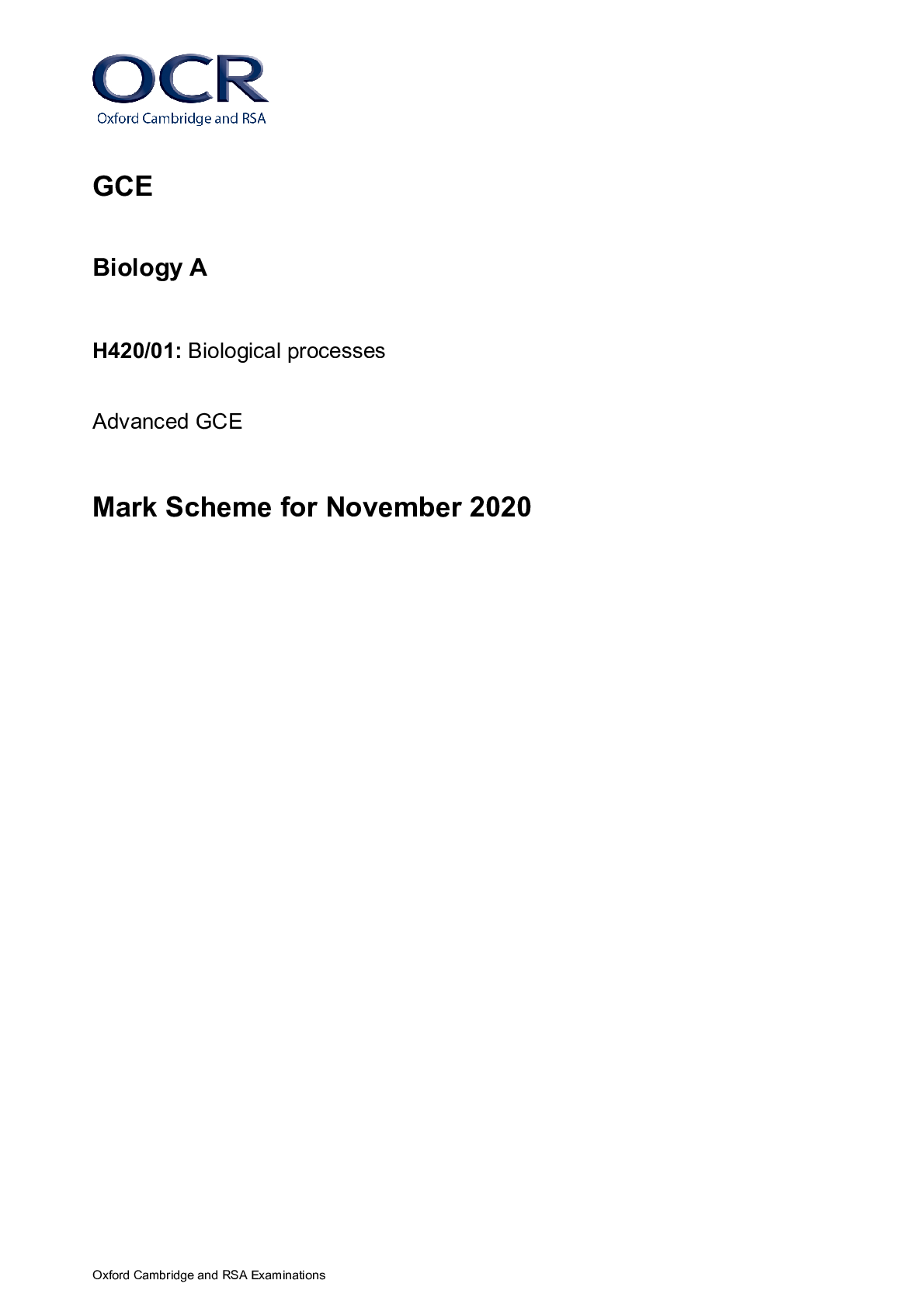
Buy this document to get the full access instantly
Instant Download Access after purchase
Add to cartInstant download
Reviews( 0 )
Document information
Connected school, study & course
About the document
Uploaded On
Oct 07, 2022
Number of pages
25
Written in
Additional information
This document has been written for:
Uploaded
Oct 07, 2022
Downloads
0
Views
72

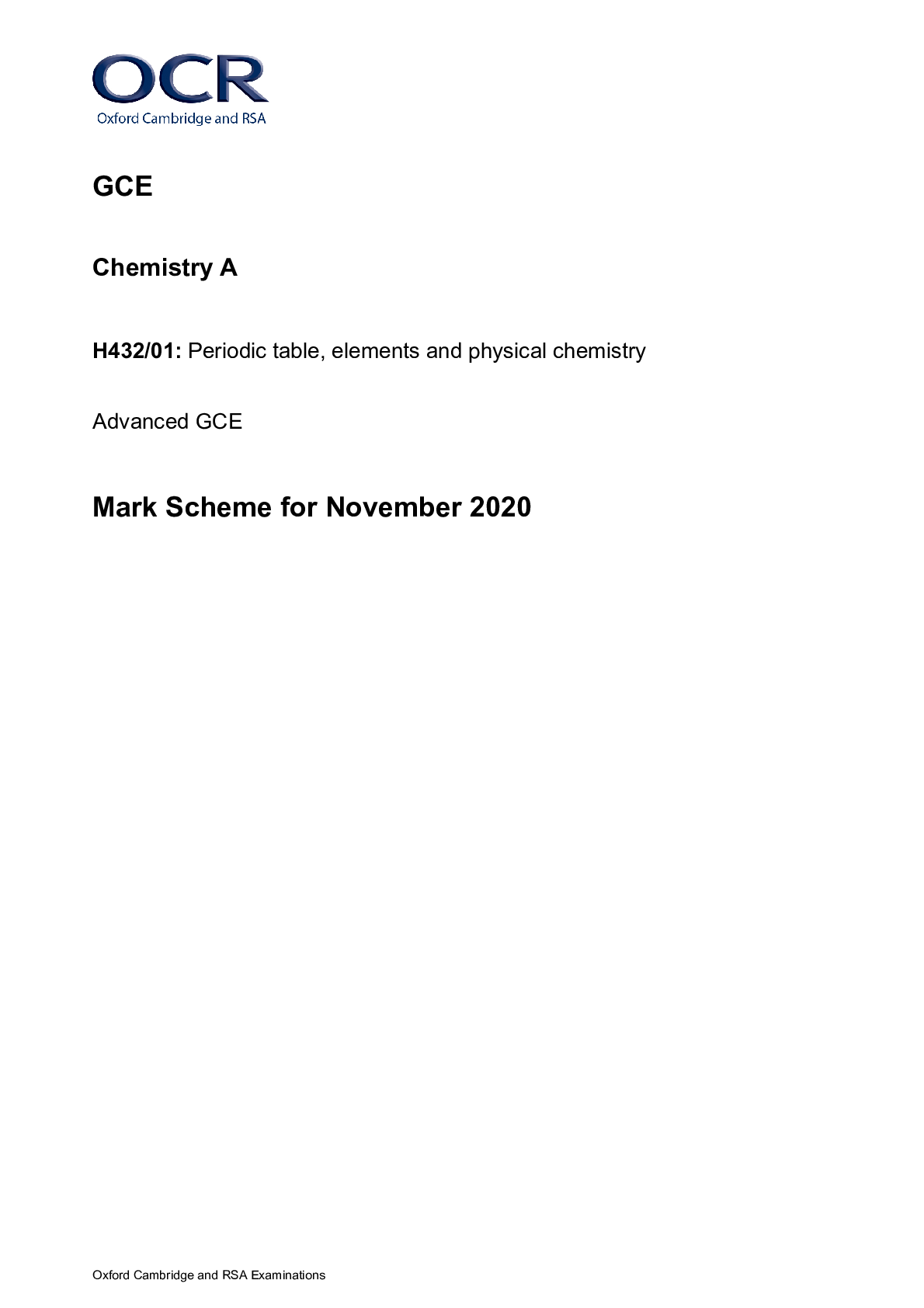

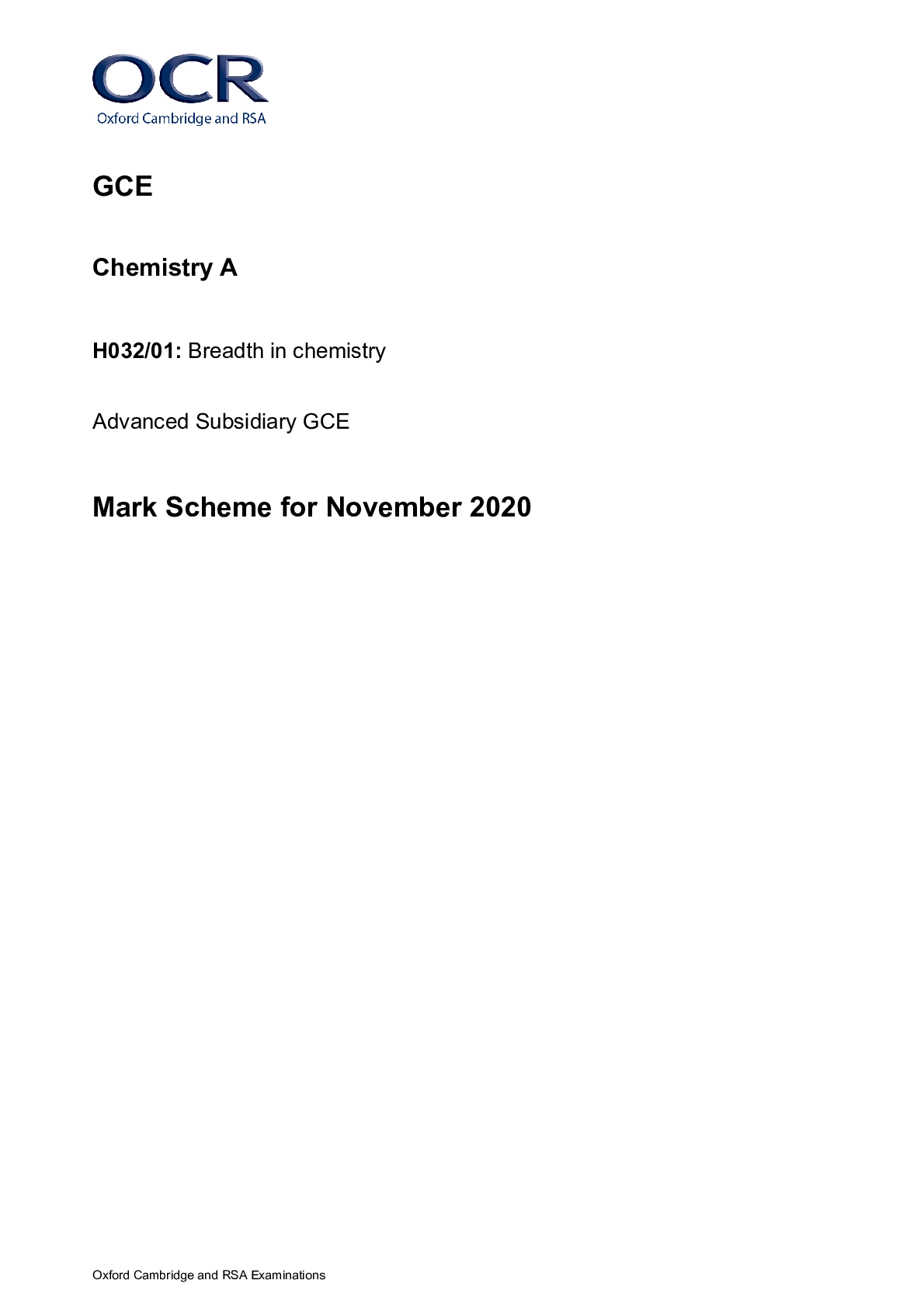


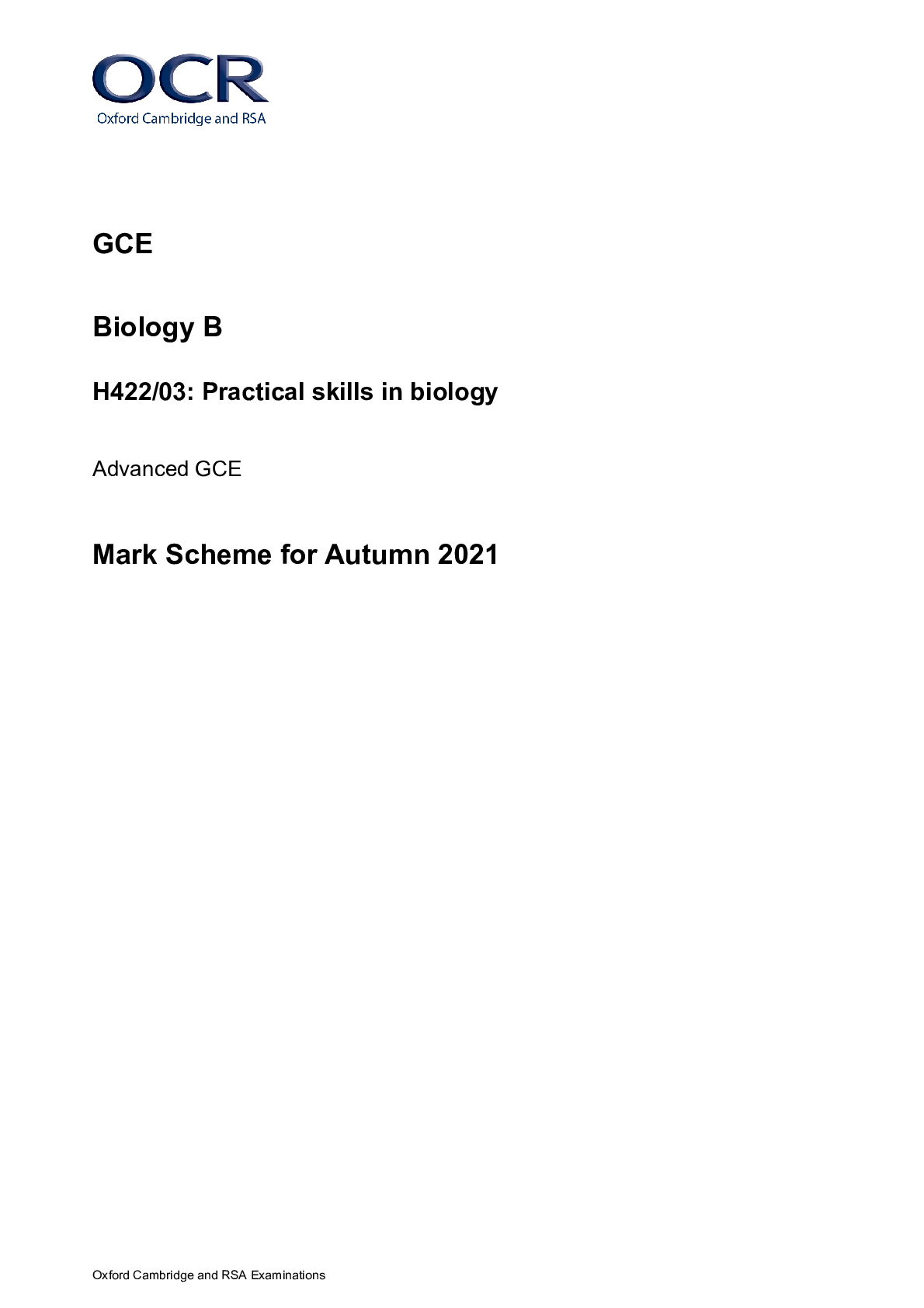

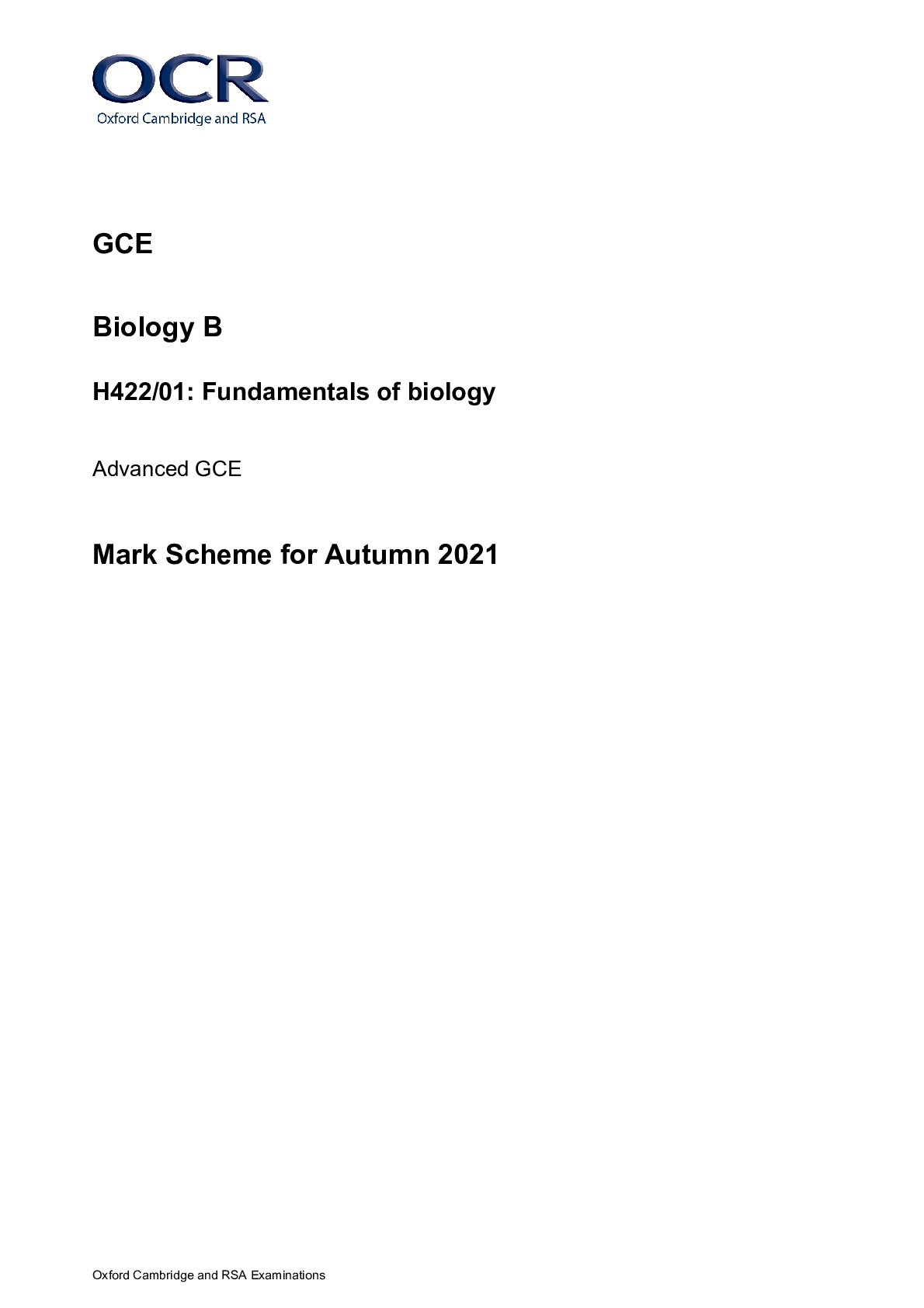
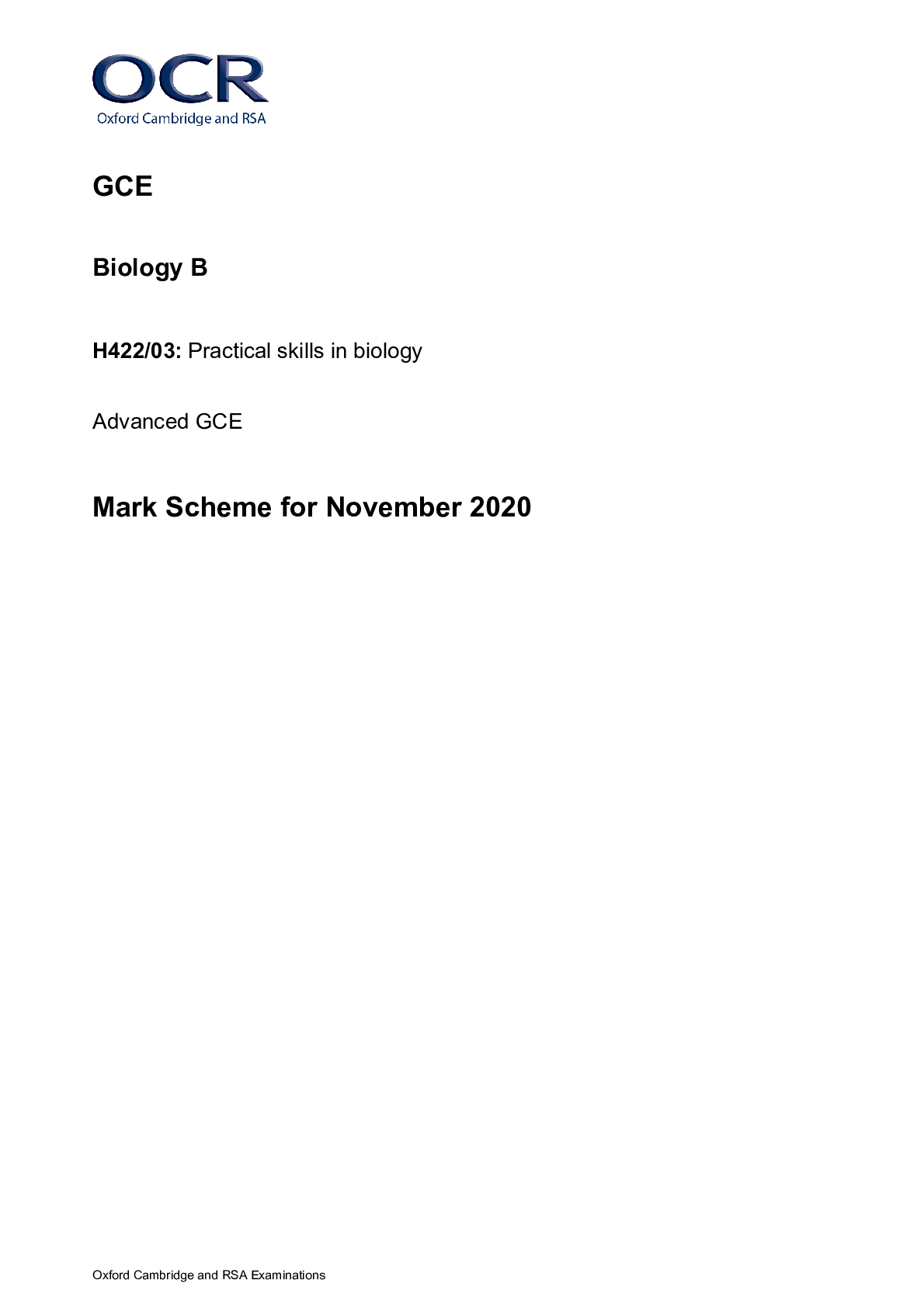
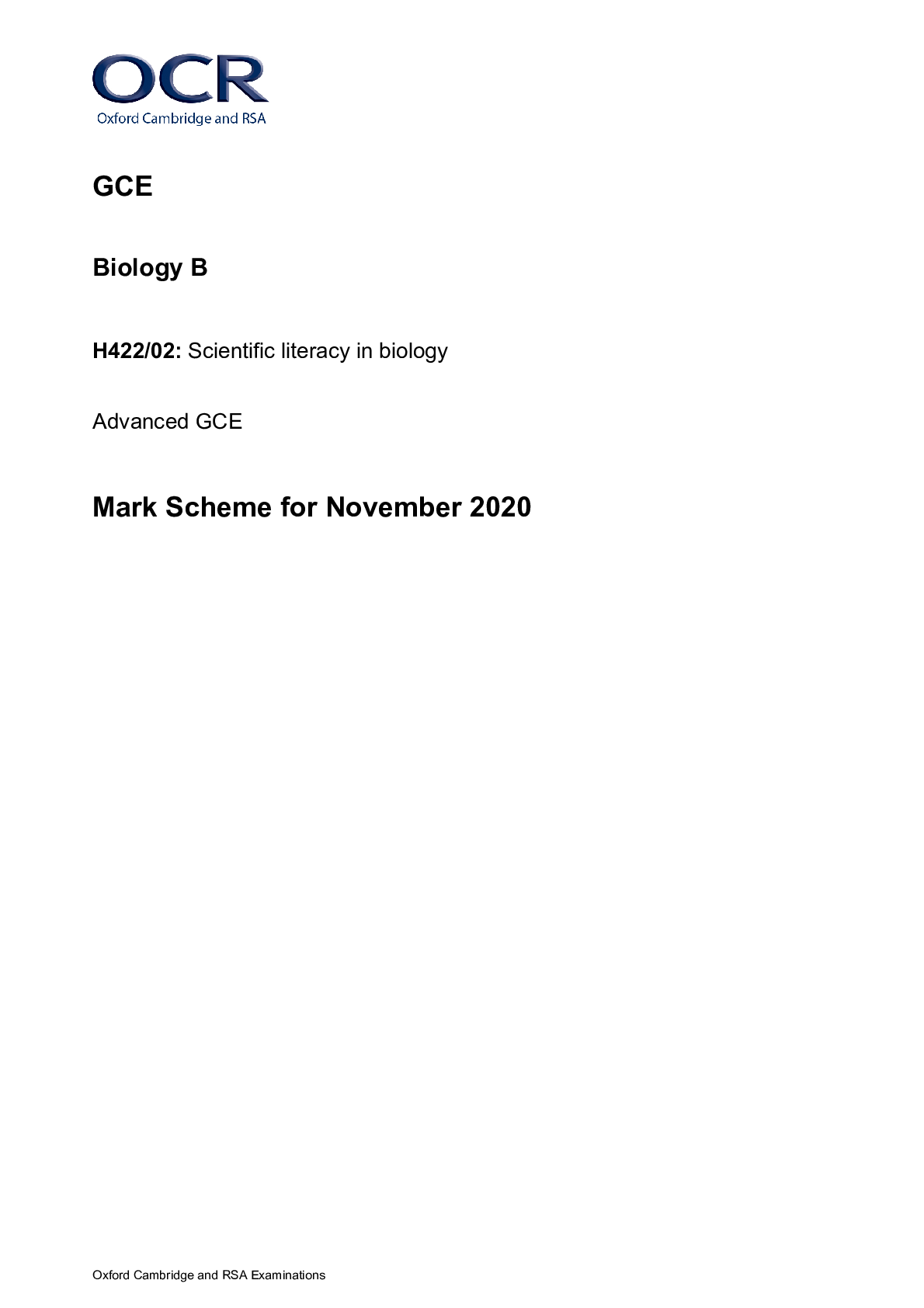
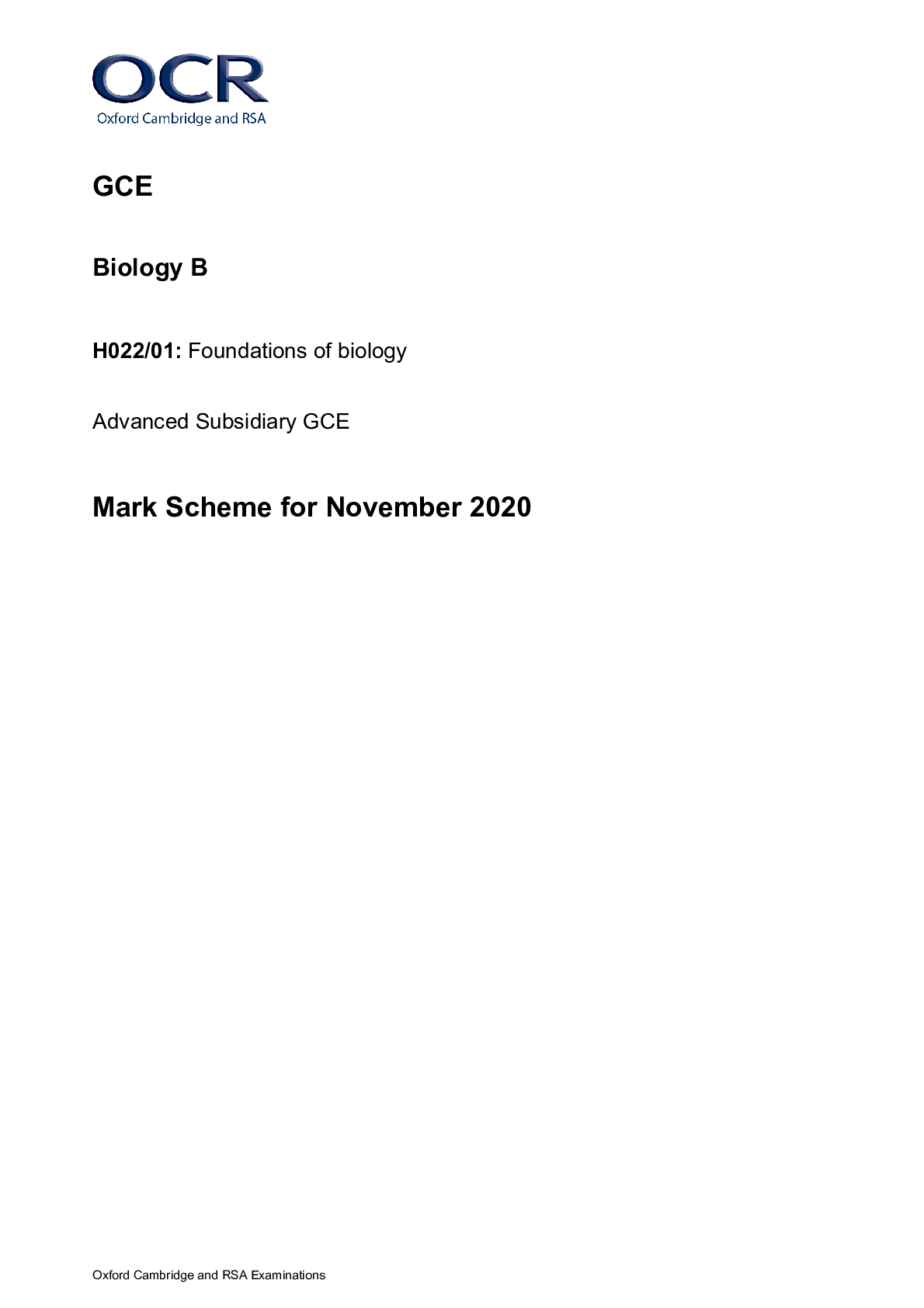




.png)
H630-02 Pure Mathematics and Statistics Advanced Subsidiary GCE Mark Scheme for Autumn 2021.png)

